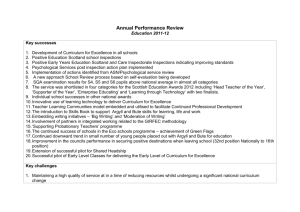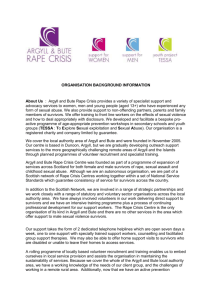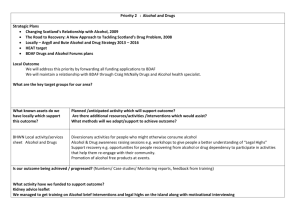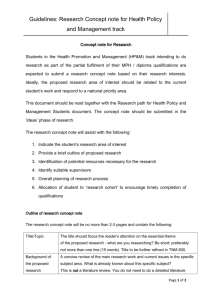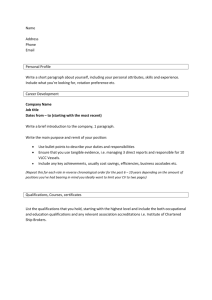scoping_paper_-_opportunities_for_all_-_v6
advertisement
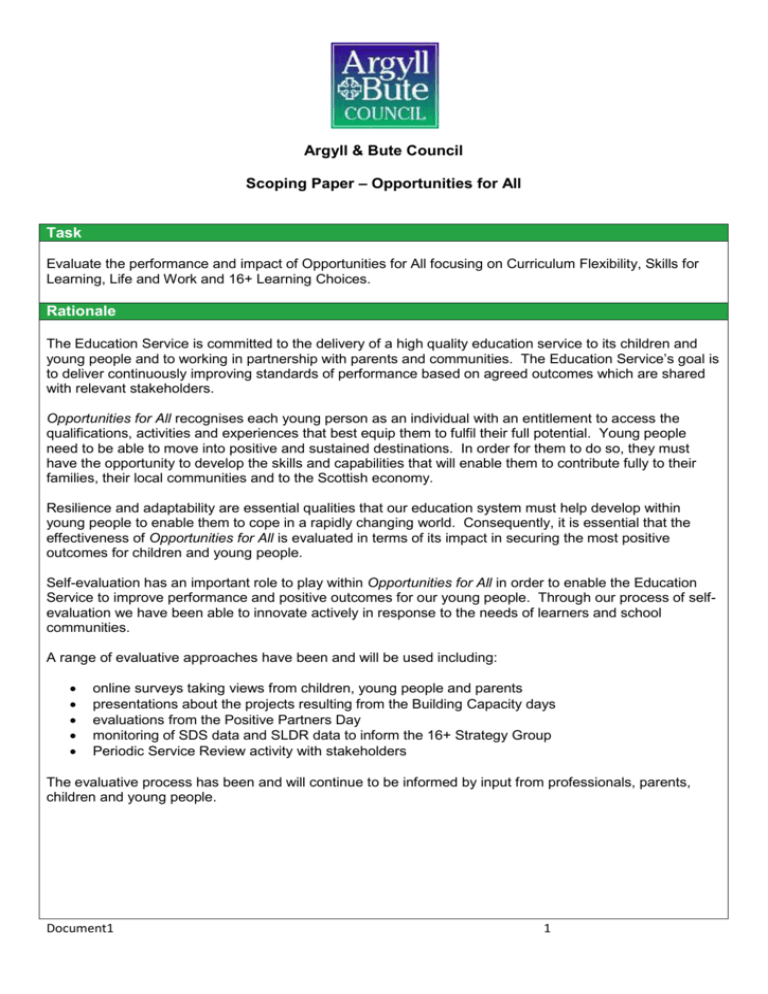
Argyll & Bute Council Scoping Paper – Opportunities for All Task Evaluate the performance and impact of Opportunities for All focusing on Curriculum Flexibility, Skills for Learning, Life and Work and 16+ Learning Choices. Rationale The Education Service is committed to the delivery of a high quality education service to its children and young people and to working in partnership with parents and communities. The Education Service’s goal is to deliver continuously improving standards of performance based on agreed outcomes which are shared with relevant stakeholders. Opportunities for All recognises each young person as an individual with an entitlement to access the qualifications, activities and experiences that best equip them to fulfil their full potential. Young people need to be able to move into positive and sustained destinations. In order for them to do so, they must have the opportunity to develop the skills and capabilities that will enable them to contribute fully to their families, their local communities and to the Scottish economy. Resilience and adaptability are essential qualities that our education system must help develop within young people to enable them to cope in a rapidly changing world. Consequently, it is essential that the effectiveness of Opportunities for All is evaluated in terms of its impact in securing the most positive outcomes for children and young people. Self-evaluation has an important role to play within Opportunities for All in order to enable the Education Service to improve performance and positive outcomes for our young people. Through our process of selfevaluation we have been able to innovate actively in response to the needs of learners and school communities. A range of evaluative approaches have been and will be used including: online surveys taking views from children, young people and parents presentations about the projects resulting from the Building Capacity days evaluations from the Positive Partners Day monitoring of SDS data and SLDR data to inform the 16+ Strategy Group Periodic Service Review activity with stakeholders The evaluative process has been and will continue to be informed by input from professionals, parents, children and young people. Document1 1 What are we evaluating? The evaluation team identified three main areas of focus within Opportunities for All; Curricular Flexibility Skills for Learning, Life and Work - Qualifications -Skillsbook - S6 Options - Building Capacity - Curriculum Developments - Sharing Good Practice 16+ Learning Choices - Early Identification - Supporting Vulnerable Groups - Leavers Information How are we doing? What key outcomes have we achieved? Improvements in Performance It is possible to use performance data and measures to show trends over time. SLDR, alternative qualifications and SQA Data trends are available for analysis and evaluation of our performance and inform improvement agendas. The quality and diversity of education provided by individual services and establishments can be demonstrated by the range of alternative qualifications being offered by schools and their local learning communities across the Authority. School review processes and partnership working help promote effective improvement planning part of which should be the identification of the extent to which wider qualifications are available to learners. These would include Duke of Edinburgh, John Muir, Prince’s Trust XL awards, ASDAN awards, Sports Leader Awards, Saltire Awards, Drivers Ed and CLD based qualifications. Argyll Voluntary Action offer Argyll and Bute Council the opportunity to be the only Authority able to provide accredited Saltire Awards. Over the last 5 years central education staff have worked in partnership with secondary schools to support them to offer a greater range of qualifications and wider opportunities to young people in order to help them move into a positive and sustained destination. The Authority recognises that in order to ensure genuine personalisation and choice for each young person, parity of esteem of academic, vocational, and social qualifications is fundamental. In session 2011-2012 a total of 621 pupils took part in Skills for Work across our 10 secondary schools and 1386 young people opted to study alternative qualifications. Graph 1 – Uptake of Skills for Work and Alternative Qualifications 2000 1800 1600 1400 1200 Skills for Work 1000 Alternative Qualifications 800 Total 600 400 200 0 2009/10 Document1 2010/11 2011/12 2 Table 1 – Uptake of Skills for Work and Alternative Qualifications COURSE/LEVEL 2009/10 419 401 820 Skills for Work Alternative Qualifications TOTAL 2010/11 647 787 1434 2011/12 621 1386 2007 Please see Appendix 1 for the breakdown listing all Skills for Work courses and Appendix 2 listing all of the alternative qualifications on offer across Argyll and Bute secondary schools over this 3 year period. The Education Service recognises the importance of responding to the need of individual young people whilst addressing the demands of local labour markets. This may result in a variation in the number of schools actively offering particular alternatives in any given year. Schools are now being asked to assess the requirement to offer alternative qualifications based upon knowledge of their local circumstances It is the intention of the Education Service that skills based needs analysis becomes standard practice as part of curriculum review arrangements and must include consultation with young people, parents, partners and employers. Curricular options and delivery will be supported by a range of appropriate professionals. It is possible to measure the suitability of the senior curriculum by analysing leaver destinations and academic progression in the senior phase. Table 2 – Leaver Destination and Attainment Progression 783 Pupils Positive Fit for Leaver Destination 655 83.65% Negative Fit for Leaver Destination 128 16.35% Showing Progression Not Showing Progression 631 80.58% 152 19.42% Table 2 shows that our current senior phase curriculum is enabling our young people to move into positive destinations but that there is still a significant number for whom this is not the case. Four out of five of our young people are following a curriculum which offers appropriate progression in attainment. However, the Education Service needs to engage with schools to discuss and analyse why this is not the case for one in five of our young people. Table 3 – Combined Leaver Destination and Attainment Progression 783 Pupils Positive Fit & Showing Progression 584 77.14% Positive Fit & No Progression 66 8.82% Negative Fit & Showing Progression 33 4.59% Negative Fit & Not Showing Progression 72 9.45% Table 3 shows there may not always be a direct correlation between positive progression and a positive destination. Given this data, the Education Service aims to develop a more detailed analysis of issues around what is being done in the senior phase that is assisting young people to move into positive destinations. As a result of an evaluation of our School Review process we have moved toward a system of Partnership Working and Partnership Agreements with schools. The focus of this work is to assist schools effect improvement. Document1 3 Considerable work has been undertaken by a consortium of partners including Psychological Services, Social Work and the Throughcare Aftercare forum, to draw up a transition protocol for those young people who are identified as having Additional Support Needs including those who are Looked After and Accommodated (LAAC). This protocol includes a timeline which must be adhered to when supporting vulnerable young people plan their transition from secondary education. From March 2012 schools have been working with the Opportunities for All Central Team to identify those young people who are at risk of not moving into employment, education or training. During their final term in school these young people are assessed by Skills Development Scotland to ascertain if they would benefit from an Activity Agreement after they leave. How well do we meet the needs of our stakeholders? Impact on Learners Qualitative and quantitative data is available and demonstrates the extent to which learners are included and participating. SQA and Authority data show levels of participation are increasing. Currently, secondary schools are provided with the Fyfe Analysis performance of SQA information to assist in their own investigation of attainment data. However, the Authority is aware that as more young people access a wider range of qualifications and Nationals are implemented, a different approach to data analysis will be required. This approach should produce a data set that is capable of evaluating all qualifications on offer. The Education Service is engaging in a deeper analysis of the achievement of all young people in S4. The apparent decline in achievement at Level 3, based upon school roll rather than presentation information, may be misleading. An increasing number of young people have chosen to pursue Skills for Work qualifications through partnerships with colleges and are therefore not included in the current SQA analysis of Level 3. The situation is further exacerbated by the range of alternative qualifications and programmes of study now on offer to young people in Argyll and Bute secondary schools. A central role of all partners will continue to be the emphasis of the equal recognition of academic and vocational qualifications. Parity of esteem is essential to allow all young people to achieve their potential. Across Argyll and Bute we have a number of young people with Additional Support Needs who now have curricular arrangements specifically tailored to their individual circumstances. A range of models of personalisation and choice are being adopted across our secondary schools and there are an increasing number of co-curricular examples such as ‘Pathways’ in Oban High School. There has been a move away from a content driven curriculum to a more skills based curriculum. A curriculum which builds skills for learning, life and work may include opportunities for study in areas such as web design, digital photography, driftwood sculpture, financial management, animal husbandry and child care as well as the development of very active social enterprise companies. The concept of learning communities and the accompanying shift in perception that has taken place in schools is having a profound impact upon what is offered as part of the school curriculum. This has encouraged establishments to find ever more innovative and creative ways of delivering diverse learning experiences to young people. As a result of this the range of qualifications being offered by Argyll and Bute schools and their partners has been extended significantly. In 2010 a Best Value Review of CLD in Argyll and Bute recommended that a Youth Service team be established to work more closely with secondary schools. In practical terms this has resulted in CLD Youth Workers working in schools to develop a wide range of activities including life skills and accredited programmes. In addition, they’ve been actively involved in identifying and working with young people at risk of not achieving a positive destination and the provision of Activity Agreements. Document1 4 Over the 4 years from 2008 to 2012 our schools have been supported in developing new curriculum models. All now have in place a model for the broad general education and a model for the senior phase. Practitioners and central staff have carried out evaluations of curriculum models throughout this period. At a recent two day Secondary Head Teachers curriculum modelling conference in Lochgilphead, participants were asked to take part in an intensive interrogation of their senior phase models, including the range of alternative qualifications on offer. A considerable amount of work has been undertaken to ensure that the range of progression routes are becoming available for a wide range of qualifications. It is our intention that qualifications available across Argyll and Bute will extend from National 2 up to degree level. The Education Service is aware that work remains to be done particularly in terms of Quality Assurance and assisting parents to understand the value and validity of certain curricular elements and innovations. The Education Service is using a Risk Matrix held on the SEEMIS system to assist schools with the early identification of children and young people who are at risk of disengaging from their learning and are at risk of not making a positive and sustained transition post-16. Using an array of 25 fields, relevant information is collated and appears as a Red, Amber or Green score (RAG) dependant on the cumulative level of concern identified across these fields. This system will ensure that robust data with regards to early identification is held across all of our education establishments. Secondary staff are in the process of being trained in how to use the Risk Matrix and further training is planned for nursery and primary staff. The Education service’s aim is that all secondary pupils will have been assessed using this SEEMIS tool by December 2012. In addition to the Risk Matrix, the Education Service has compiled relevant paperwork for all secondary schools to use when recording senior phase leaver destination information. The new Leavers Pack has been developed in partnership with appropriate Depute Head Teachers, Guidance Teachers, Administrative Staff and Skills Development Scotland. The Leavers Pack consists of: 1. S4/5/6 transition planning XL spreadsheet 2. 16+ Learning Choices Leavers Form 3. Guidelines for recording pupil destination using GIRFEC tab on SEEMIS Secondary schools have been trained and issued with guidance on these new procedures during the course of the last academic session. The key aim of the Leavers Pack is to ensure that all senior phase leaver information is accurately recorded with known destinations as appropriate. In addition the transition planner will allow the Authority to identify gaps in future post-16 provision and begin to address these gaps timeously with our partner agencies. Activity Agreements are now available for those young people struggling to make a positive and sustained post-16 transition. During their final term at school pupils may now be referred to Skills Development Scotland for an Activity Agreement assessment to be completed. Those young people identified at being a risk are assigned a Trusted Professional and may begin on an Activity Agreement as soon as they have officially left school. This early intervention helps to prevent young people becoming further disengaged through unemployment. SLDR data allows the Education Service to monitor and track how many young are entering and sustaining a positive destination post-16. Document1 5 Table 4 - SLDR Annual Trends YEAR NO OF LEAVERS HE % FE % Training % Employed % Voluntary work % Other Known/ AA U/E Seeking % U/E not Seeking % Not Known % 2008 2009 2009 2010 2010 2011 972 38.6 20.4 3.3 24.8 0.4 N/A 10.4 1.3 0.8 957 35.1 19.4 3.6 29.3 0.4 N/A 10.6 1.1 0.5 985 35.9 22.6 3.0 27.8 0.3 0.1 9.4 0.6 0.1 Overall the percentage of leavers entering a positive destination in 2010/11 is 89.8%, a rise of 2% from the previous year, and giving the Authority a ranking of 11th highest out of the 32 local authorities. The percentage of leavers reported as unemployed seeking has fallen to 9.4%, a fall of 1.2% points since last year. The Authority now has the 16th lowest percentage of leavers becoming unemployed whereas last year it was the 18th lowest. Of those reported as unemployed seeking in September 2011, 41.3% were still in this situation in March 2012. A breakdown of the SLDR by individual schools can be found in Appendix 3. The Education Service’s commitment to ensuring that all learners have the opportunity to become successful learners, confident individuals, responsible citizens and effective contributors, requires that the widest range of learning need is accommodated within all educational settings. To this end the Education Service aims to be fully compliant with the principles and practice embodied in Getting it Right for Every Child. Use of the GIRFEC Practice Model for assessment and support has been adopted as the standard model across all educational establishments and across all services. Multi-agency training and GIRFEC workshops continue to be offered across the Authority. As part of the Education Service’s efforts to address the wider needs of learners in all educational settings, Education Support Officer input is made available to educational establishments to assist them in developing strategies, procedures and protocols to support learners with particular behaviour needs. These may arise from social and emotional difficulties as well as difficulties such as Autism Spectrum Disorder and ADHD. Providing inclusive strategies for managing behaviour is central to the learning success of many of our young people. The Education Service is committed to delivering the Scottish Government Opportunities for All initiative. Opportunities for All is an explicit commitment to offer a place in learning or training to every 16-19 year old who is not currently in employment, education or training. It will ensure that the post-sixteen system focuses on supporting those at risk of disengaging and those who have already done so and should seek to reengage all young people appropriately with learning or training between their 16th and 20th birthdays and enable support to be offered to young people more effectively beyond that age. Education Services Opportunities for All team has recently been involved in developing: 1. An Argyll and Bute Youth Employment Action Plan 2. An Argyll and Bute Skills Pipeline In addition the Authority hosted a Rural Action Forum on Youth Employment with the Scottish Government on the 18th September in Oban. Document1 6 How good is our leadership and management? Leadership, Improvement and Quality Assurance The Education Service is confident that it will have robust evidence upon which to base its evaluation of Opportunities for All. Current evidence suggests that significant improvements have been made in providing positive outcomes for young people and that as a service we have become more open and inclusive in our professional practice. The Education Service has identified that leadership and management of the process has been reactive rather than proactive with regards to Opportunities for All. Our self-evaluation using the Scottish Government 16+ Learning Choices Toolkit helped us to look closely and honestly at our performance as a service provider. Over the course of the last eighteen months we have progressed from being classified as a high risk to a low risk authority, moving from 32nd to 16th place. Having made an assessment of the needs of establishments and stakeholders, we have attempted to address our findings by putting solutions in place and developing the skillsets of our staff. We have centrally developed and provided ‘products’ to assist educational establishments widen the range of activity and opportunity on offer. We have provided a range of staff training opportunities including Child Protection, Risk Matrix, skillsbook, Trusted Professionals and Coordinators Training. Our model has been to audit, identify need, centrally source solutions and then provide appropriate training and structure for partners to take things forward. The Education Service has the capacity to continue improving. Effective Quality Assurance arrangements will require to be further developed. We have a high level of confidence in our developing process of evaluation, which will utilise a range of data gathering approaches including: online surveying to evaluate suitability and highlight areas requiring further improvement and development short term pilots across multiple subject areas investigating ‘workability’ and stakeholder understanding of the language of skills and the development of skills progression an evaluation of skillsbook a recall day for building capacity an evaluation of the use of 16+ Learning Choices related policy and procedures by schools and partner agencies How do we know? Performance Data Argyll and Bute Council use a range of performance information which includes: Fyfe Analysis of SQA Data Risk Matrix analysis and timeline Positive Partners Evaluation Alternative qualifications on offer across secondary schools Transition spreadsheets for each school across each year group Social Work LAAC transition spreadsheets for ABC SLDR – October 2011 and February update 2012 plus now June 2012 update Activity Agreement Analysis – June and September quarterly return Analysis of SLDR data for 2011 against educational attainment Statistical analysis of pupils using skillsbook Document1 7 Stakeholder views and feedback Approaches for gaining insight into the experiences of our stakeholders include; Meet with Activity Agreement young people Opportunities for All Cowal Locality Group Meeting Opportunities for All Strategy Group Meeting Meet with pupils using skillsbook Meet with skillsbook group Meet with Early Years staff developing skillsbook Direct observation of practice Examples of good practice from Argyll and Bute secondary schools includes: Pathways Project at Oban High School E-Portfoilo move to skillsbook Co-curricular at Islay High School skillsbook pilot at Dunoon Grammar School Dunoon Grammar School S5 list Columba 1400 in Dunoon and Campbeltown as these areas are unemployment hotspots Feast of Talent – Rothesay Academy Local Authority Argyll 100 initiative Positive Partners Evaluation Opportunities for All Argyll and Bute Council Scottish Government Action Plan and Report 2012/13 Argyll and Bute Council DMT paper on Opportunities for All, Argyll 100 and Columba 1400 Risk Matrix Training Pack Argyll and Bute Council Senior Phase Leaver Policy and Procedures Activity Agreement Policy and Procedure brochure and relevant statistical analysis SDS: Argyll and Bute Council Community and Planning Partnership Report (Feb12) Argyll and Bute Council Opportunities for All 16+LC Timeline Argyll and Bute Council CfE – 16+LC: Senior Phase 15-18 Argyll and Bute Council Opportunities for All Newsletters Argyll and Bute Council Work based Vocational Learning Policy and Procedures Skills Argyll and Bute Council Skills Framework Argyll and Bute Council Skills good practice CD Statistical analysis of pupils using skillsbook Recall day – 10 pilot project descriptions S6 Partnership with UHI Discussion paper for proposal S6 Pupil information booklet S6 Options a guide for Parents and Carers S6 Option Choice booklet Frequently asked questions paper for Senior Leaders Frequently asked questions paper for Students Qualifications Fyfe analysis of SQA data Alternative qualifications on offer across each secondary school Analysis of SLDR data compared with educational attainment Skills for Work Partnership Agreement with Argyll College Argyll and Bute Council Columba 1400 discussion paper Dunoon Grammar School pilot paper *All of the above documentation can be accessed from the online folder Document1 8 What are we going to do now? The Education Service is committed to continuing to embed, develop and grow Opportunities for All approaches across the Authority. This will be achieved through: using performance data to identify areas of development for Opportunities for All gathering and collating stakeholder views’ and feedback to improve delivery of outcomes analysing data to inform improvements in curriculum flexibility Curricular Flexibility continued development of academic and vocational curriculum better consultation and analysis of local labour market needs development of curricula relevant to young people and their local context Skills for Learning, Life and Work implementation of skillsbook evaluation of skillsbook – June 2013 building capacity, ongoing development and sharing good practice monitoring and evaluating by the Skills Strategy Group 16+ Learning Choices continued work with schools to embed 16+ Learning Choices policy and procedures implementation of Risk Matrix procedures, supported by training of all appropriate staff through partnership working with Social Work and Education Psychology, focusing on supporting vulnerable groups through their post-16 transition Document1 9 Appendix 1 - Skills for Work Qualifications COURSE/LEVEL Creative Design Media Int 1 2009/10 0 2010/11 26 2011/12 19 Construction Int 1 53 65 60 Construction Int 2 37 20 33 Cosmetology 15 0 0 Early Education and Childcare Int 1 110 138 102 Early Education and Childcare Int 2 0 41 45 Engineering Int 1 0 4 8 Financial Services Int 1 Hairdressing Int 1 15 53 6 64 0 85 Hairdressing Int 2 10 7 24 Hospitality Int 1 42 54 50 Hospitality Int 2 26 17 47 Motor Vehicle C&G Int 1 Rural Skills Int 1 10 29 41 56 26 60 Rural Skills Int 2 Sport and Recreation Int 1 Uniformed and Emergency Services Int 1 9 0 10 7 15 86 17 7 32 General Operations Hospitality NC TOTAL 0 419 0 647 6 621 Document1 10 Appendix 2 – Alternative qualifications on offer COURSE/LEVEL ASDAN – bronze ASDAN – silver ASDAN – gold ASDAN - new horizons ASDAN – transition challenge ASDAN – Work Right ASDAN – towards independence ASDAN – COPE Beauty Therapy Higher BSC First Aid BSC Basic Food Hygiene Certificate BSC Health and Safety at Work BSC Lifting and Handling Digital Photography Duke of Edinburgh – Bronze Duke of Edinburgh – Silver Duke of Edinburgh – Gold ECDL Creative Computing Int 1 Enterprise and Employability – NPA Personal Finance – Intermediate 2 Recording Financial Transactions HN Unit Friends Against Bullying (FAB) Health and Social Care – Higher John Muir Leadership – Intermediate Two/Higher Princes Trust XL PD – Access 3 Psychology – Intermediate 1 Psychology – Intermediate 2 Psychology – Higher SALTIRE Awards Scheme Youth Achievement Millennium Volunteer Awards (50-200) Sports Coaching Award – Tennis Level 1 Sports First Aid Sports Leader Award SFA Early Touches – Football Getting Started – Basketball Pool Lifeguard SQA Personal Development Award – Int 2 Tutoring Work Experience - Intermediate 1 YASS – S6 Open University TOTAL Document1 2009/10 66 12 4 0 0 0 0 0 11 22 16 12 12 6 63 27 10 3 6 65 6 0 0 0 3 0 0 2 3 0 0 13 26 0 3 2 0 0 4 0 0 2010/11 45 25 6 8 3 4 12 10 0 0 244 47 0 20 41 8 1 3 0 99 8 0 0 9 10 0 8 0 20 0 0 2 70 1 12 70 0 0 0 0 0 2011/12 7 21 5 8 3 4 12 10 0 0 204 24 0 20 49 39 10 33 0 80 10 2 25 6 51 25 16 2 5 6 70 2 68 5 0 59 14 14 0 2 28 0 4 401 0 1 787 439 8 1386 11 Appendix 3 – School Leaver Destination Return by School 2010 / 11 2010/11 NO OF LEAVERS HE FE Training Employed Voluntary work Other Known/ U/E Seeking U/E not Seeking Not Known % +ve AA Campbeltown Grammar 84 27.4 Dunoon 185 33.5 Hermitage Academy 247 Islay 26.2 2.4 34.5 0.0 0.0 8.3 1.2 0.0 90.5 28.6 4.9 23.2 0.0 0.0 9.2 10.0 0.5 90.3 43.3 21.9 2.8 17.4 0.8 0.4 13.0 0.4 0.0 86.6 32 18.8 9.4 0.0 53.1 0.0 0.0 12.5 6.3 Lochgilphead High 87 36.8 13.8 0.0 42.5 0.0 0.0 6.9 0.0 0.0 93.1 Oban 202 35.1 16.8 4.0 34.2 0.5 0.0 8.9 0.5 0.0 90.6 Rothesay Academy 83 36.1 41.0 3.6 9.6 0.0 0.0 8.4 1.2 0.0 90.4 Tarbert Academy 31 38.7 12.9 3.2 38.7 0.0 0.0 6.5 0.0 0.0 93.5 Tiree High 9 33.3 11.1 0.0 55.6 0.0 0.0 0.0 0.0 0.0 100 Tobermory High 25 32.0 24.0 0.0 44.0 0.0 0.0 0.0 0.0 0.0 100 TOTAL 985 35.9% 22.6% 3.0 27.8% 0.1% 9.4% 0.6% 0.1% 89.8 Grammar 0.0 81.3 High High 0.3% Document1 12
